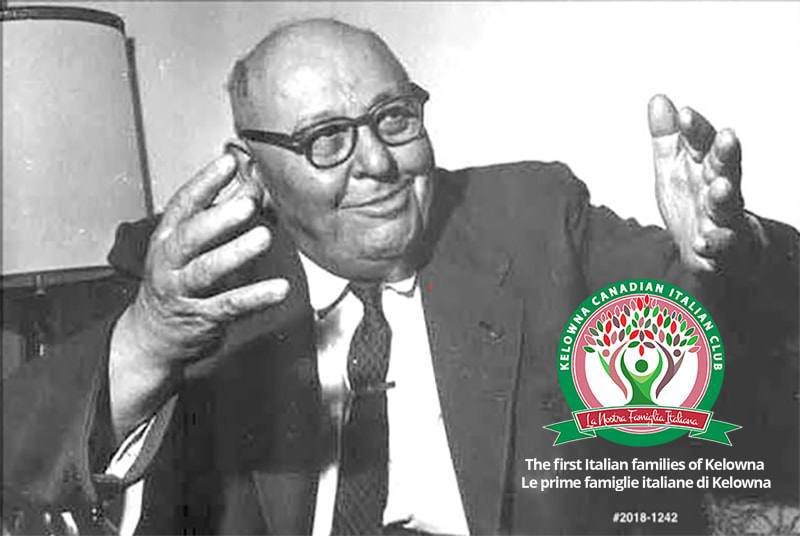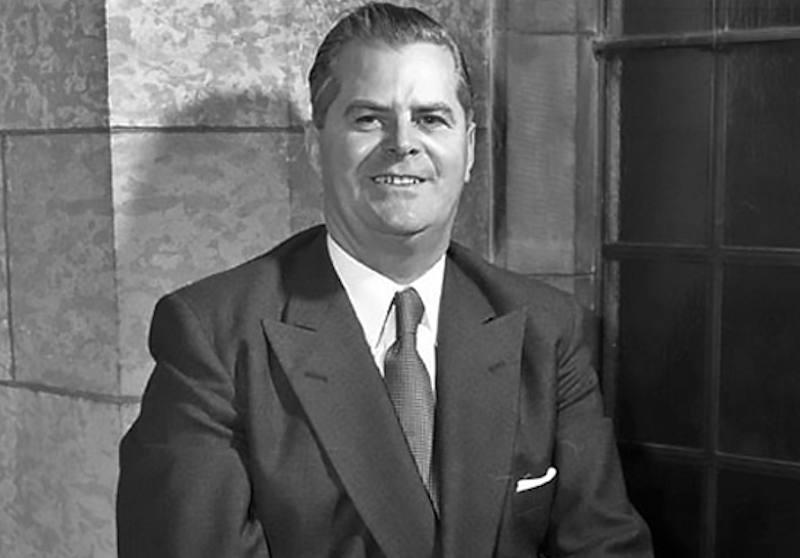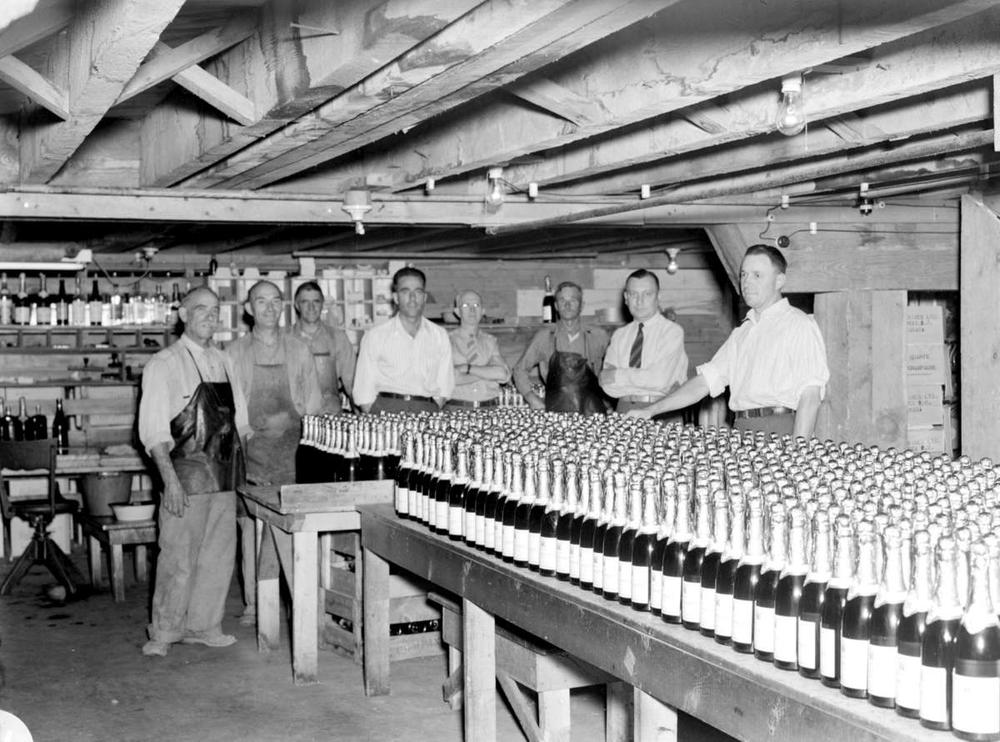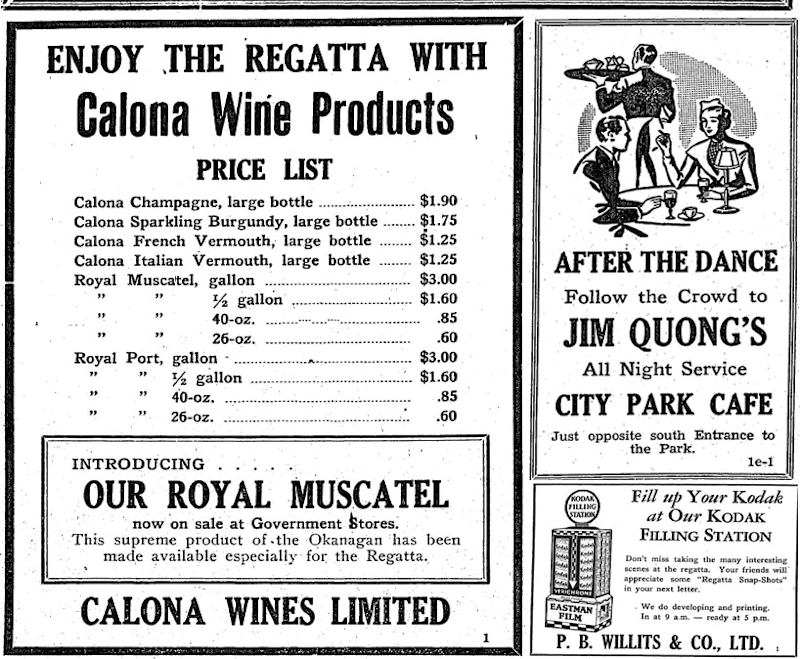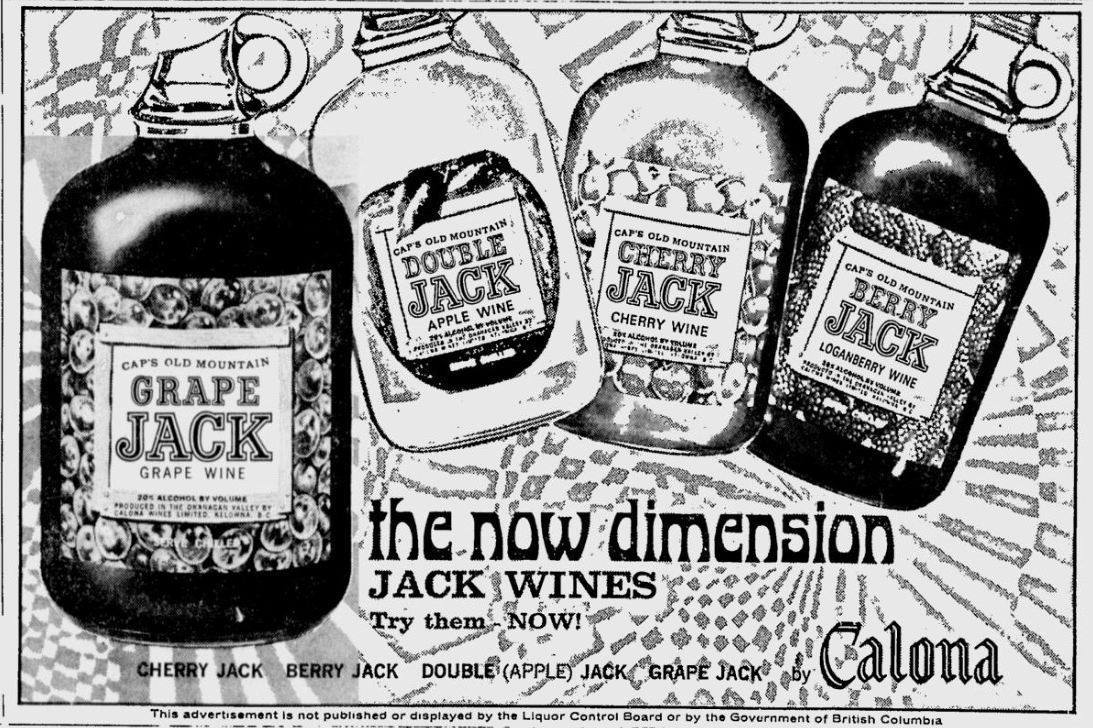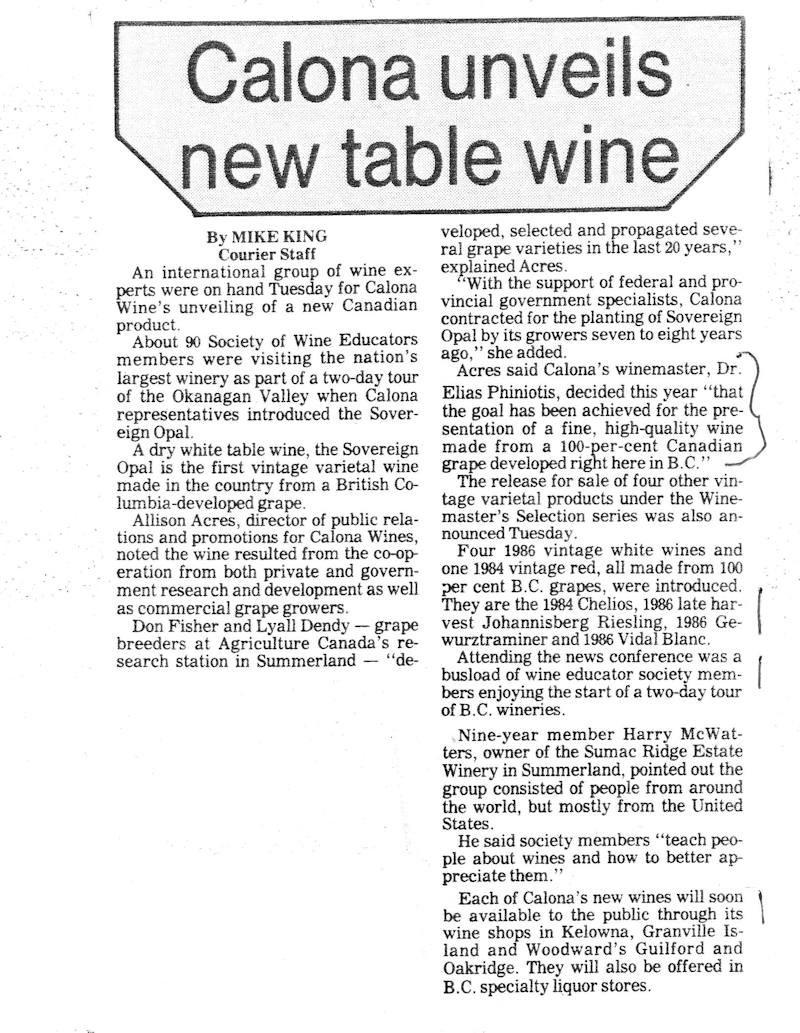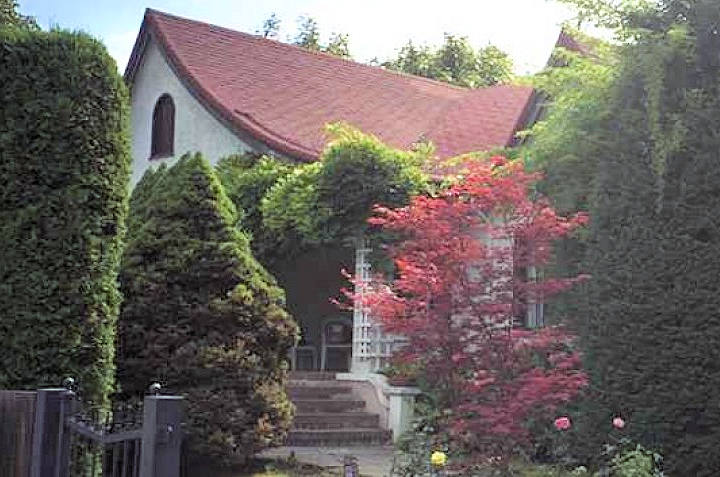Robert Bell's
Wines of Canada
Since 1992
Calona Wines Ltd
A history
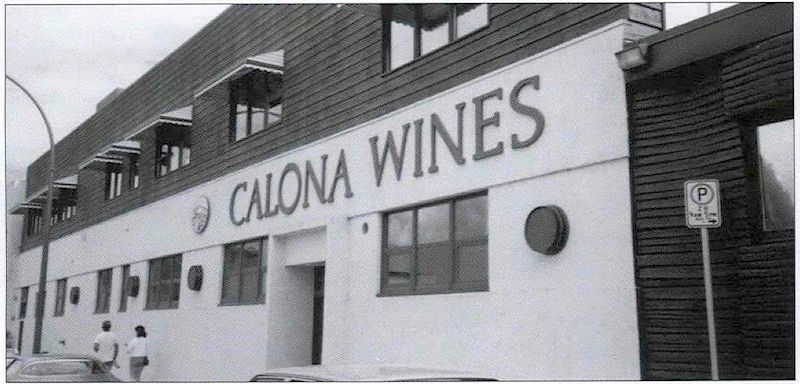
Calona Wines Ltd.: The largest and oldest continuing winery in British Columbia, it was conceived by Guiseppe Ghezzi, who put together a syndicate in 1931 to raise $10,000 for the purchase of wine-making equipment. He relied on Peter Casorso to tap fellow farmers in the Kelowna area but when the fundraising fell short, the syndicate in 1932 turned to outsiders, including two of Kelowna's rising businessmen, Pasquale (Cap) Capozzi and W.A.C. Bennett, who subsequently raised additional funds, largely from the Italian community in Trail. (Thanks to the smelter there, citizens of Trail in the Depression still had cash to invest, unlike the Okanagan's farmers.)
Bennett became the president, Capozzi vice-president; the other directors were drawn entirely from Kelowna's non-Italian business community with the exception of one original member of the Ghezzi syndicate, John Maggiora, who ran the Westholme Hotel in Victoria. While Ghezzi and Casorso sought backing from the Okanagan farmers, Maggiora negotiated with a consulting chemist in Turin, Italy, Dr. Eudo Monti, who wanted to sell certain patent rights to the new venture for $3,000. The chemist arranged the shipment to Kelowna of grape concentrate and equipment for wine-making and fruit concentrating. While the files of correspondence on these transactions are incomplete, the relationship with Monti lasted several years. The winery sent him samples of its first wines to evaluate and invited him to visit Kelowna.
Pasquale (Cap) Capozz
W.A.C. Bennett
Launched in 1932, the winery was called Domestic Wines and By-Products Ltd. because the investors intended to make not only apple wines but also "apple cider ... brandy, alcohol, spirits of all kinds, fruit juices, soft drinks, fruit concentrates, jelly, jams, pickles, vinegar, tomato paste, tomato catsup, tomato juice and by-products of every kind." One early letter to Dr. Monti reports that "we have a large demand for concentrated apple juice from England."
The winery had a shaky start. In a booklet written for its fiftieth anniversary, Calona admitted: "The company's original apple wines -- Okay Red, Okay Clear, Okay Port and Okay Champagne -- were a bitter disappointment. Many bottles refermented on liquor store shelves and had to be thrown out." With experience and with the use of grapes in 1935, the wines improved. The company now called itself Calona, a name plucked from a competition among consumers and not, as some have maintained, because it was the phonetic way in which the Italians spelled Kelowna.
1932
1932 Calone wines warehouseSales were slow at first, confined mainly to the Okanagan. In the last two weeks of November 1932, the Liquor Control Board sold 262 bottles through its nineteen stores, including seventy bottles at the Kelowna store and forty-three in Penticton and Vernon. When Bennett complained, an LDB official wrote: "I think possibly you are unreasonable in expecting any large turn-over on this brand of wine, as it will naturally take you some little time to get it properly introduced." In its first financial statement, for the period from February 28, 1932 to September 30, 1933, the winery had sales of $13,204.19 and a profit of $554.49. In that report Bennett wrote: "The Company has gone through an experimental period, perfecting the manufacture of the different kinds of wines now being sold, and with all the opposition and obstacles it had to contend with, it is gratifying to report that there is a balance on the right side after writing off heavy depreciation."
Barely surviving its first decade, Calona began growing when wartime and a military base at Vernon brought cash and customers into the Okanagan. For example, sales reached $95,236.59 in the year ended January 31, 1942, with a profit of $4,007. In 1951 the winery moved from the warehouse it had rented into a purpose-built winery at what became its permanent Kelowna location. In 1960 the cautious Carlo Ghezzi retired, handing over management to the aggressive Capozzi family: Cap and his three sons. The youngest of the three, Herb, after a successful career as a football tackle with the Montreal Allouettes and the Calgary Stampeders, entered politics in 1966 and was a Social Credit member in Vancouver Centre for two terms. But with Joe Capozzi as production manager and Tom Capozzi as executive vice-president and sales manager, Calona went from being the smallest winery in British Columbia to the largest, overtaking Growers' Wines of Victoria.
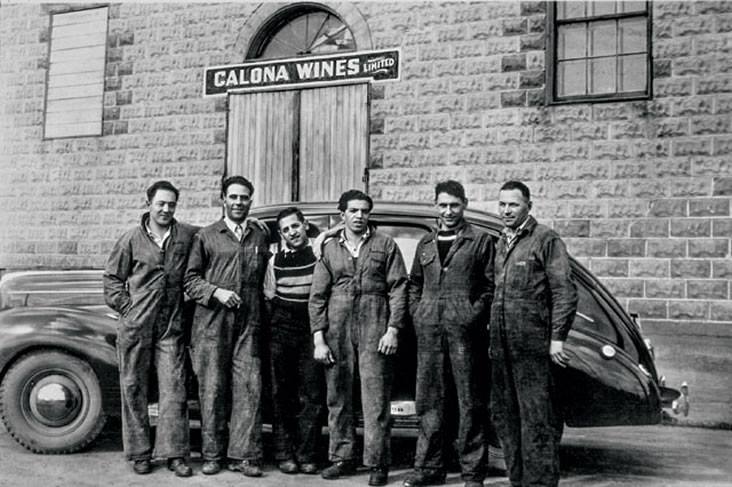
While Growers' products remained in dull packaging, Calona updated both its packages and labels, scoring a particular success with a bottle that resembled a decanter. Calona's sales people also were more aggressive in pursuing listings in the liquor stores. Herb Capozzi's renown as a football player and banquet speaker -- where he plugged Calona and usually insisted Calona wines be served -- gave the entire Capozzi family and their winery useful recognition among liquor store clerks awed by celebrity. By 1967 Calona was the sales leader and spent close to $1 million that year on what Cap Capozzi called "the most modern and up-to-date winery in all of Canada." The British Columbia wine industry grew more competitive in 1967 when both Casabello and Mission Hill opened. But at December 1967, Calona had 38.6 per cent of the wine sales in British Columbia (and was selling as far afield as New Brunswick), compared with 33 per cent for Growers, 15 per cent for Andrés, 10 per cent for Villa Wines (soon to be acquired by Growers') and 1.5 per cent each for Mission Hill and Casabello. According to the Beverage Alcohol Reporter, in a November 1968 article, Calona's sales had risen from $478,000 in 1960 to an estimated $3,700,000 in 1968.
While wine consumption was already rising quickly, the Capozzi brothers hurried their business along even faster by copying whatever worked for the successful Gallo brothers in California. When Gallo released fruit wines, Calona followed in February 1968 with Double Jack, Berry Jack and Cherry Jack, fortified with spirits made in Calona's own distillery. At $1.40 for a forty-ounce bottle and $2.70 for an eighty-ouncer, these wines were a hit across western Canada By the end of the decade, the Capozzi brothers even invited Gallo to buy forty-nine per cent of Calona but balked when Gallo wanted fifty-one per cent. Tom Capozzi later admitted that one strategy adopted from Gallo did not serve Calona well. Like Gallo in the United States, Calona tried to supply the entire Canadian market from one large, efficient winery at a time when Calona's competitors in Canada built smaller wineries in almost every province in exchange for preferred listings in each of those provinces. Calona only opened a second winery in 1973, in Ste-Hyacinthe, in an effort to break into the exceptionally protectionist Quebec market. The winery lost money and was sold in 1974 to Andrés.
Jack Wines: Calona Wines launched this family of fortified pop wines early in 1968 after producing a trial 40,000-gallon lot in 1967. The wines were so well received that 260,000 gallons were made in 1968. The wines were Double Jack, made from apples; Cherry Jack; Berry Jack (loganberries) and Grape Jack. All were fortified to a resounding twenty per cent alcohol with spirits that Calona made in its new distillery. (Indeed, in 1968, thirteen of Calona's wines were similarly fortified.) The winery recommended that the Jack wines be served well chilled, "for entertaining or after dinner." They were called Jack wines because the original intention was to call the apple wine Applejack. This was not allowed by the regulators since Applejack is distilled apple brandy by definition.
August 2nd, 1938 Kelowna Courier Regatta Extra edition
During the early 1960s archival Growers' bought 16,882 shares in Calona. There was no possibility of Growers' gaining control since Capozzi Enterprises Ltd., the family company, had accumulated 61,120 shares by 1968 and Tom Capozzi owned another 1,089. Ever the deal maker, Tom Capozzi flew to Montreal and proposed to Imperial Tobacco, Growers' parent, that Growers' buy Calona. Imperial turned him down and Capozzi had to get used to the fact that his biggest competitor, as a substantial shareholder, was receiving Calona's annual report, even if disclosure was minimal (the 1968 report even omitted the annual sales).
Note: Finley, William E: Consulting winemaker whose credits include chief enologist at Calona during the 1960s and winemaker at Okanagan Vineyards in the early 1980s.
Growers' president Brian Roberts attended the Calona shareholders' meeting June 28, 1968, grilling the Capozzis on everything from the non-disclosure of sales to the nature of a $21,200 investment by the winery in something called McCan Holdings Ltd. Later, Roberts reported in a memorandum to Imperial Tobacco that this was a sixteen per cent investment in "a new chain of drive-in restaurants known as MacDonalds [sic]." Roberts added that he conducted himself at his rival's meeting with the "essence of courtesy... [But] notice has definitely been served on the Capozzis that they are now being watched like hawks." Evidently, Imperial Tobacco was not interested in keeping that close an eye on the Capozzis. In October 1968 Growers' offered its shares to Capozzi Enterprises for $25 each, an aggressive request, since the Capozzis had a standing offer of only $15 a share. "Because we felt that it was not good business to have a competitor as a shareholder, we purchased these shares," Tom Capozzi wrote to the remaining minority shareholders, offering them same. Most accepted; Capozzi Enterprises had almost ninety per cent of the shares when the offer expired. By 1971, Calona was selling wines across Canada (1970 sales were $5.6 million) and the company had decided to open the winery in Quebec. The Capozzi family put the winery back on the market, getting $9.6 million from Standard Brands Ltd. of New York. The new owner was not interested in keeping Calona's stake in the hamburger chain and Calona sold the shares back to McDonald's for $1 million.
Calona's portfolio at this time still was dominated by fortified or sweet wines, often packaged in eccentric bottles (another idea copied from Gallo). Only a quarter of its sales in 1972 were dry table wines. Standard's managers realized that the future would be in table wines and hired a new winemaker, Bob Claremont, to produce them. Claremont was given stainless steel tanks and a properly equipped laboratory; and he bought more premium grapes and fewer of the labrusca varieties that had been serviceable for old style products as Royal Red and the fortified wines. In short order Claremont overhauled the entire table wine portfolio, crafting such wines as Sommet Rouge in 1974 and Sommet Blanc in 1975, both of which were dry and were packaged in standard Bordeaux-style bottles closed with corks. In 1977 Claremont created Schloss Laderheim, a white wine cleverly packaged in a brown hock bottle with a Germanic label. In 1981 Schloss outsold Baby Duck -- 589,000 cases to 571,000 cases -- to become the top selling domestic wine.
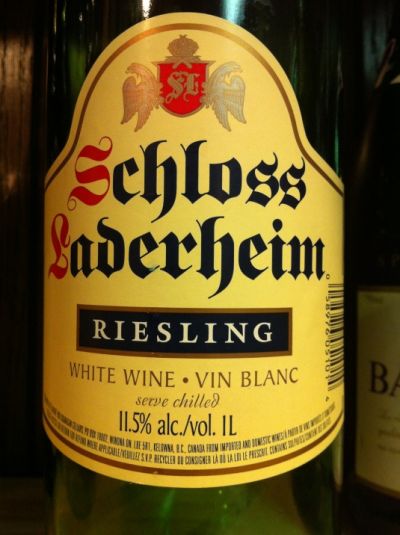
While proprietary wines like Schloss have been Calona's bread and butter ever since, the winery also began releasing varietal table wines in the late 1970s, starting with maréchal foch and rougeon and, with the 1981 vintage, expanding to include Riesling, Gewurztraminer, Chenin blanc and chancellor.
At Calona, Elias Phiniotis was a one-person winemaking revolution. Calona owned a number of large oak vats which had been in use for many years and had become totally encrusted internally with tartaric acids and other deposits. The vats still softened the wine during storage but had long since ceased giving any oak complexity to the wines. Phiniotis had them scraped and shaved; it refreshed the vats and, starting with the 1981 vintage, Calona began producing better reds than it had ever made. He also permitted the red wines to go through malolactic fermentation, an established winemaking technique elsewhere but almost unheard of then in the Okanagan. With this technique, Phiniotis softened the Okanagan's naturally tart acids and also added some flavor complexity to his wines. The varietals included chancellor, maréchal foch and rougeon, all of them hybrids. Most acreage of foch and rougeon was pulled out after the 1988 harvest but Calona had such substantial quantities in its vats, particularly of rougeon, that the vintages of the late 1980s stayed on the market, won several awards and became so popular that Calona subsequently urged some growers to replant the variety.
In the 1990s, under winemaker Howard Soon, small oak barrels were installed in the cavernous winery and Calona started making barrel-fermented chardonnays and Merlots.
The winery changed owners again in May 1989 when International Potter Distilling Corp. of Vancouver bought Calona for $16.9 million from Heublein Inc., an American conglomerate into which Standard had been absorbed earlier. In 1995 Potter changed its name to Cascadia Brands Inc., a name thought better suited for export sales of wine, cider and beer, the latter from a sister company, Granville Island Brewery.
Capistro: This was a brand name under which Casabello launched so-called light wines in 1982 -- called light because the alcohol was reduced to seven-eight per cent and the wines therefore had fewer calories. The idea seems to have come from the California wine industry where Sebastiani Vineyards of Sonoma in 1981 claimed to be the first to release a light wine. Several other British Columbia wineries soon followed Casabello's lead: Calona's light wine was called Tiffany and was aimed, to quote Calona literature of the day, "primarily to women concerned with their health and lifestyle, as well as to those who follow trends." These wines only were popular for a a few years, until the calorie counters moved on to mineral waters and the real wine lovers rediscovered real wine. Sebastiani dropped its light wine in November 1993. "Light wines are not perceived as quality," explained Sam Sebastiani, then the winery's president.
Carlo Ghezzi, 1899-1963): Born in San Bonifacio near Verona in Italy, he interrupted his technical school education to enlist in the Italian air force when he was seventeen. While he learned to fly, the war ended before he could be thrust into combat. In 1921 he emigrated to Canada, apparently to join his father. Like his father, he changed his surname to Ghezzi from Brena (signing himself as Carlo Brena Ghezzi). Having some chemical and technical training, Carlo succeeded his father as the winemaker at Calona Wines, subsequently also becoming general manager until he retired in 1960. A quiet, formal man, Carlo Ghezzi was troubled throughout his life by an energy-sapping heart condition. He managed the winery as carefully and cautiously as he managed his own finances. While he doted on his only daughter, Linda, she also recalls an occasion when he flatly refused her money for the movies. In a fit of pique, she tore down all of the non-smoking signs in the winery.
Ghezzi, Guiseppe (1867-1943): The real founder of Calona Wines Ltd., Guiseppe Ghezzi lived a life dramatic enough for the opera. To begin with, Ghezzi was not his real name. He was born Cleto Candido Desiderato Patrizio Brena at San Bonifacio, a community southeast of Verona in northern Italy. Brena, as he was known until he came to Canada, was the son of an orphan, Camillo Brena, whose surname came from his mother because the father was unknown. The entrepreneurial Cleto Brena, after completing technical school studies and getting married in 1892, established his own business in San Bonifacio making cravats and other silk products. Throughout his life, he dressed as elegantly as only a silk manufacturer would. An adventurer, he also was driving in automobile races in Rome as early as 1905. Brena's business appears to have suffered a serious reversal, causing him to set out for North America without his family in 1912 to rebuild his fortunes, choosing a new name in the new world. Settling in Winnipeg, Ghezzi worked first in the Winnipeg office of a firm of Italian wine merchants, Luigi Calissano & Figlio of Alba. Subsequently, he had a leading role in the mid-1920s in organizing a colony for Italian farmers near the Winnipeg suburb of St. Boniface, the name of which had a comfortable resonance.
Ghezzi family records offer few clues as to why he moved on to Kelowna in 1931, organizing a syndicate of investors to fund a winery, with his son, Carlo, as the winemaker. Ghezzi's wife had died in Italy in 1922 and some of their five children (all with given names starting with C) began to follow the father to North America. One son became a wine merchant in New York; one daughter married an Italian businessman in Modesto, California; and another settled in Yakima in Washington. Family recollections have Ghezzi visiting his far-flung family and remarrying (to a soprano who had performed at Milan's famed La Scala opera house). Ghezzi, who was Calona's winemaker throughout 1933, eventually moved on, returning to Italy permanently in 1938. He died at San Bonifacio five years later.
Ghezzi's credit as instigator of the winery rests on a one-page handwritten document by him, dated November 25, 1931. It describes an agreement drawn up earlier that month, providing for a group of investors to lend $10,000 to the Interior Co-operative Association to purchase equipment for a winery. Ghezzi himself contributed $1,500 to the investment pool, followed by Peter Casorso ($1,000); Mary Casorso ($250); and a Victoria hotel operator, John Maggiora ($1,250). When Ghezzi's original pool of investors came up short, Kelowna businessmen Pasquale Capozzi and W.A.C. Bennett joined the syndicate in 1932, with Bennett providing the leadership until he entered politics in 1941.
Capozzi, Pasquale (1889-1976): Colorful CapCapozzi -- his friends called him Cap while his family called him Pats, a corruption of Pasquale -- was the Italian grocer behind Calona Wines Ltd. Born at Santo Stephano del Sole, near Naples, Capozzi emigrated to Canada in 1906, worked as a railroad laborer in western Canada until he concluded that he could do better selling groceries. He managed the company store at the smelter in Trail (another source has him running a grocery at Revelstoke) and in 1917 opened a store in Phoenix, briefly a thriving copper mining town with seventeen bars in southern British Columbia, near modern-day Greenwood. Phoenix died with the collapse of copper prices after the First World War and Capozzi headed for the Okanagan. Family legend has it that he settled in Kelowna in 1919 when he spotted a large field of ripe tomatoes there and remarked that an Italian can never starve where tomatoes are grown.
The winery in 1932 was the brainchild of Guiseppe Ghezzi who believed there would be good business in converting the Okanagan's surplus apples into wines but needed Capozzi's help to raise the money. Capozzi and another Kelowna merchant, W.A.C. Bennett, raised much of it from the Italian community in Trail, one of the few islands of prosperity in British Columbia during the Depression. Sales of shares to investors sometimes were closed with what Cap's son, Tom Capozzi, called the telegram trick: midway through a meeting with these investors, a prearranged telegram would arrive from the winery trumpeting yet another large order for its wines.
Cap Capozzi stayed in the background at the winery for years. Bennett, even though he did not drink, was its president until he was elected to the British Columbia legislature in 1941. He sold his interest to Kelowna car dealer Jack Ladd, who was president until his death in 1957. Cap and his family began buying back the shares that he had sold in the 1930s. By 1960, he was president and he installed sons Tom and Joe in management at the winery, Cap and his family having acquired almost total control of Calona. He remained chairman until retiring in 1971. The winery was sold to Standart Brands/Nabisco
Neither a winemaker nor a connoisseur, Cap certainly was a determined partisan of his wines. The most oft-repeated Cap Capozzi story, verified by son Tom, relates that Cap once was panhandled on a Vancouver street by a man who wanted a quarter for a drink. "How do I know," Cap asked, "that you won't spend it on coffee?"
Capozzi HouseThe Capozzi House has significant heritage value for its close association with one of the community's prominent early citizens. This was the long-time home of Pasquale ('Cap') Capozzi, a business and community leader. He came to Canada from Italy in 1907, at the age of 18. After operating grocery stores in Revelstoke, Trail, and Phoenix, he arrived in Kelowna in 1919 and opened a grocery in the old Lequime building at the foot of Bernard Avenue. The City Grocery (later called Capozzi's Cash Grocery) later moved to 279 Bernard Avenue and operated there until 1962.
By the 1930s Capozzi was branching out in business. Along with Guiseppe Ghezzi and W.A.C. Bennett, he started Domestic Wines and By-Products Ltd. (later Calona Wines) in 1931, which originally intended to produce apple wine but switched to grapes in 1934. In doing this the three partners laid the beginnings of the thriving Okanagan Valley wine industry.
Capozzi was also involved in the founding of Okanagan Broadcasters (station 10-AY, subsequently CKOV radio). He started buying real estate in downtown Kelowna and throughout the southern interior in the mid-1930s and became an important developer. His largest project was the Capri Hotel and Shopping Centre, opened in 1958. ('Capri' comes from the combination of 'Capozzi' and 'Pridham' - 'Cap' from the instigator and 'Pri' from the owner of the land.)
This attractive house, built for Capozzi in 1928 by well-known local builders Maranda and Patterson, has value as a representative example of a late-1920s modest, middle-class house (built while Capozzi was still a grocer by trade). Its cute asymmetrical design is derived from the Arts-and-Crafts cottage of a decade or two earlier. Capozzi and his wife Maria (who he had met in Phoenix, and married in 1921) lived here until at least 1966. Minor alterations were recorded in 1942.Enrico Guidi, (1917-1993): Born in Kelowna of Italian immigrant parents, Guidi joined Calona Wines when he was seventeen. In his forty-three-year career there, he rose to become the cellarmaster, a post in which he was responsible for blending hundreds of wines.
In 1980 Howard Soon joined the winery. He went on to be the head winemaker at Sandhill and later was awarded the "Order of CAnada"
Calona Vineyards Today
Calona's VQA wines are released under the Artist Series label, with artists competing to design the collector-quality labels. Icewines are released under the Private Reserve label. Sovereign Opal is unique to Calona Wines. It is the only wine grape developed at the Summerland Research Station that made it into commercial production.“Conviction is a name that reflects our conviction to making approachable and fruit-forward wines, which showcases exactly what Calona has always represented,” said Conviction winemaker Sydney Valentino.
The winery is owned by Andrews Peller Limited. THey closed the winery perhaps because one of their stars Sandhill WInery wwas near by!
Resources:
John Schreiner
British Columbia Wine Companion
Calona Wines
Memorandum in Lloyd Schmidt files.
Calona Wines: Golden Anniversary, booklet published by the winery in 1982.
A Traveller's Guide to Historic British Columbia, by Rosemary Neering, Whitecap Books
Kelowna Canadian Italian Club
City of Kelowna
Winesofcanada.com
|
